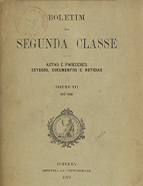

................................
Published for thirty years (1903-1933), the Boletim da Segunda Classe [Bulletin of the Second Class] (Minutes, Communications, Opinions, Studies, Documents and News) filled a significant documentary gap in the record of the intellectual life of the Academia das Ciências de Lisboa [Lisbon Academy of Sciences] (ACL) during the period 1898-1929. The publication begins by noting, "Minutes of academic sessions have not been printed since 1851" (vol. I, 1898, p. VI). In 1898, Teófilo Braga (1843-1924), a full member of the class, was an influential figure. Two decades later, he would be commemorated by his disciple António Ferrão, president of an idealised institution positioned in opposition to the ACL, the Academy of Sciences of Portugal (António Ferrão, As Causas «Ideais» da Conflagração e a Função Pedagógica das Academias Científicas após a Guerra , 1918).
The end of the 19th century was evidently a period of transition, bridging those who had lived and worked alongside Alexandre Herculano with newer generations of academics and researchers. On 1 February 1898, the death of João Pedro da Costa Basto, a former official of the Torre do Tombo (1876-1880), marked another setback in the publication of the Portugaliae Monumenta Historica . Following his passing, his brother and former assistant, José Manuel, requested to be relieved of his responsibility for the História dos Descobrimentos Portugueses [History of the Portuguese Discoveries]. The Boletim recounts the history of this project, tracing its origins back to Andrade Corvo and Pinheiro Chagas in 1882 and 1892, respectively (vol. I, 1898, pp. 28-38).
Like its successor, the Boletim da Academia das Ciências [Bulletin of the Academy of Sciences], the Boletim da Segunda Classe initially consisted of monthly issues compiled into annual volumes. From the fourth issue onwards, it began to span periods covering multiple years, such as November 1916 to October 1917, representing a complete academic season. This foundational structure is outlined in volume III: "This Boletim , published in fascicles to ensure its content remains timely and relevant, is divided into two parts: the first consisting of the correspondence of the Class and opinions presented at its respective sessions; the second comprising studies, communications, documents, and news designated for publication, with a French summary of content that may be of interest abroad" (vol. III, 1909-1910, pp. 2-3). Such a summary, however, quickly becomes obsolete. The Boletim , in the words of Teófilo Braga, oscillates between "purely literary matters, such as the reading of poetry, prose excerpts, and translations of notable works" (which he advocates and defends) and "the investigation of points and questions of mere erudition and study, as is generally the tendency in organisations of this nature" (Vol. I, 1898, p. 60). The first line of the programme appears to have been successful from the session held on 30 March 1898 onwards, as the extensive documentary transcripts were significantly reduced after this approach was introduced. Over time, however, these transcripts came to dominate the printed pages, to the extent that reports of sessions, admissions, and communications nearly disappeared. As is typical of periodical narratives, it becomes essential to understand the institution's dynamics in the field of letters. This includes knowing who attends the academic sessions, participates in them, is admitted to the class, the reasons for their inclusion, and their progression within the hierarchy (if any). This will be examined further below.
This work is financed by national funds through FCT - Foundation for Science and Technology, I.P, in the scope of the projects UIDB/04311/2020 and UIDP/04311/2020.
